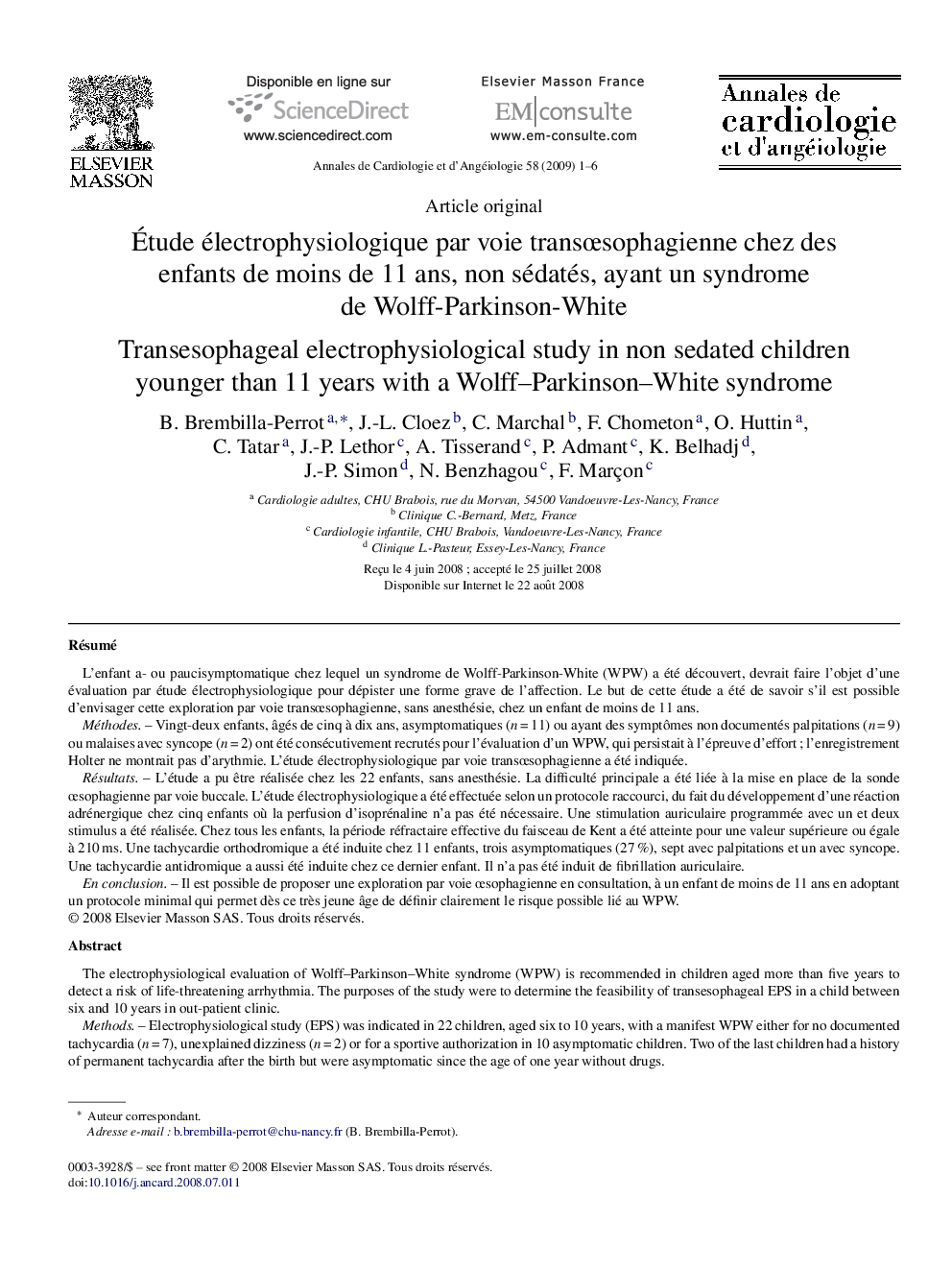| کد مقاله | کد نشریه | سال انتشار | مقاله انگلیسی | نسخه تمام متن |
|---|---|---|---|---|
| 2869505 | 1171251 | 2009 | 6 صفحه PDF | دانلود رایگان |

RésuméL’enfant a- ou paucisymptomatique chez lequel un syndrome de Wolff-Parkinson-White (WPW) a été découvert, devrait faire l’objet d’une évaluation par étude électrophysiologique pour dépister une forme grave de l’affection. Le but de cette étude a été de savoir s’il est possible d’envisager cette exploration par voie transœsophagienne, sans anesthésie, chez un enfant de moins de 11 ans.MéthodesVingt-deux enfants, âgés de cinq à dix ans, asymptomatiques (n = 11) ou ayant des symptômes non documentés palpitations (n = 9) ou malaises avec syncope (n = 2) ont été consécutivement recrutés pour l’évaluation d’un WPW, qui persistait à l’épreuve d’effort ; l’enregistrement Holter ne montrait pas d’arythmie. L’étude électrophysiologique par voie transœsophagienne a été indiquée.RésultatsL’étude a pu être réalisée chez les 22 enfants, sans anesthésie. La difficulté principale a été liée à la mise en place de la sonde œsophagienne par voie buccale. L’étude électrophysiologique a été effectuée selon un protocole raccourci, du fait du développement d’une réaction adrénergique chez cinq enfants où la perfusion d’isoprénaline n’a pas été nécessaire. Une stimulation auriculaire programmée avec un et deux stimulus a été réalisée. Chez tous les enfants, la période réfractaire effective du faisceau de Kent a été atteinte pour une valeur supérieure ou égale à 210 ms. Une tachycardie orthodromique a été induite chez 11 enfants, trois asymptomatiques (27 %), sept avec palpitations et un avec syncope. Une tachycardie antidromique a aussi été induite chez ce dernier enfant. Il n’a pas été induit de fibrillation auriculaire.En conclusionIl est possible de proposer une exploration par voie œsophagienne en consultation, à un enfant de moins de 11 ans en adoptant un protocole minimal qui permet dès ce très jeune âge de définir clairement le risque possible lié au WPW.
The electrophysiological evaluation of Wolff–Parkinson–White syndrome (WPW) is recommended in children aged more than five years to detect a risk of life-threatening arrhythmia. The purposes of the study were to determine the feasibility of transesophageal EPS in a child between six and 10 years in out-patient clinic.MethodsElectrophysiological study (EPS) was indicated in 22 children, aged six to 10 years, with a manifest WPW either for no documented tachycardia (n = 7), unexplained dizziness (n = 2) or for a sportive authorization in 10 asymptomatic children. Two of the last children had a history of permanent tachycardia after the birth but were asymptomatic since the age of one year without drugs.ResultsEPS was performed in all children. The main difficulty lied in passing the catheter through the mouth. Programmed stimulation at cycle length of 380 ms was performed in all children to avoid high rates of pacing when the conduction through the accessory pathway (AP) and normal AV system was evaluated. Isoproterenol was not required in five children, because they developed a catecholaminergic sinus tachycardia. The AP refractory period was determined in all children between 200 and 270 ms. Orthodromic reentrant tachycardia (RT) was induced in 11 children, three asymptomatic children (27%), seven complaining of tachycardia and one with syncope. Rapid antidromic tachycardia was induced in this last child with dizziness. Atrial fibrillation was never induced.ConclusionsEsophageal EPS can be performed without sedation in a young child six to 10-year-old with a shortened protocol of stimulation, which was capable to clearly evaluate the WPW-related risks.
Journal: Annales de Cardiologie et d'Angéiologie - Volume 58, Issue 1, February 2009, Pages 1–6